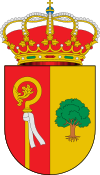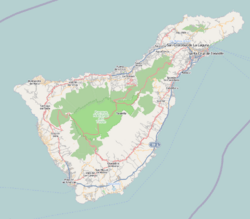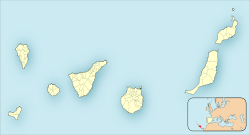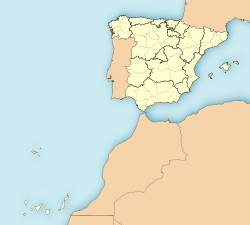Arona, Tenerife facts for kids
Quick facts for kids
Arona
|
|||
|---|---|---|---|
|
Municipality
|
|||

|
|||
|
|||
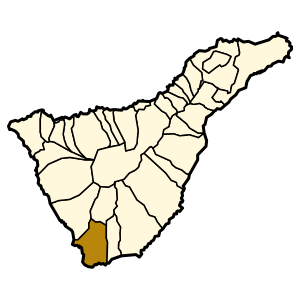
Municipal location in Tenerife
|
|||
| Country | |||
| Autonomous Region | Canary Islands | ||
| Province | Santa Cruz de Tenerife | ||
| Island | Tenerife | ||
| Area | |||
| • Total | 31.58 sq mi (81.79 km2) | ||
| Population
(2018)
|
|||
| • Total | 79,448 | ||
| • Density | 2,515.83/sq mi (971.37/km2) | ||
| Time zone | UTC+0 (WET) | ||
| • Summer (DST) | UTC+1 (WEST) | ||
| Post Code |
38640
|
||
| Climate | Csb | ||
| Website | www.arona.org | ||
Arona is a town located on the southern part of Tenerife island. Tenerife is one of the Canary Islands, which are part of Spain. These islands are found in the Atlantic Ocean.
Arona covers an area of about 81.79 square kilometers. This is about 4% of the whole island. The town of Arona is 59 kilometers southwest of Santa Cruz de Tenerife, which is the capital city of the island. In 2017, Arona had about 93,496 people living there. This makes it the third largest city in Tenerife. Only Santa Cruz de Tenerife and San Cristóbal de La Laguna are bigger.
Arona is known for its pleasant weather. Temperatures usually stay between 20 and 25 degrees Celsius. Many people visit the tourist areas here, like Los Cristianos, Playa de las Americas, Costa del Silencio, and Las Galletas. Arona also has Punta Salemas, which is the southernmost tip of Tenerife island. The main highway, called TF-1, goes right through the municipality.
Contents
History of Arona
For many centuries, not many people lived in the Arona area. An early writer, Viera y Clavijo, mentioned a small village named Arona. However, a church was not built there until the 1600s. This church became a full parish church in March 1796.
Until the 1900s, the main jobs in Arona were fishing and farming. Farmers grew crops like bananas and raised cattle. They also harvested cochineal, which is a type of insect used to make red dye. There was also a small quarry in the fishing village of Los Cristianos in the 1800s.
In the first half of the 1900s, Arona's population grew slowly. This was despite problems like low prices for cochineal and a general decline in farming. The Spanish Civil War also affected the area.
However, in recent years, Arona has grown very quickly. It has become a very popular place for tourists to visit. The number of people living here jumped from 13,556 in 1981 to 28,208 in 1996. By 2005, the population was over 60,000. To compare, in 1901, only about 2,000 people lived in Arona. Today, about 60% of the people who work in Arona are employed in the tourism industry.
Since 2015, the town of Los Cristianos in Arona has been the main office for the Islamic Federation of the Canary Islands. This group connects different Muslim communities and associations across the Canary Islands.
Education in Arona
Arona is home to a few international schools.
- Wingate School is a British international school located in Arona.
- Svenska Skolan Teneriffa, which is the Swedish school on Tenerife, is also in Arona.
Notable Areas to Explore
Arona has several interesting places to visit, especially for tourists.
Central Park of Arona
The Central Park of Arona (known as Parque Central de Arona in Spanish) was finished in 2004. It is a large city park, covering four hectares. The park was designed by architects and biologists. It has a big collection of tropical palm trees. There is also a rocky area with plants that are native to this part of the island.
Los Cristianos
Los Cristianos is one of the most important tourist centers on the south coast of Tenerife. It used to be a quiet fishing village. Over the last 20 years, it has grown a lot and is now a busy holiday spot.
Las Galletas
Las Galletas is another fishing village. It is located between Los Cristianos and the Tenerife South Airport. This village also has some places for tourists to stay and enjoy. It has become a tourist resort as well. The beach at Playas de Las Vistas has been improved with sand brought from the sea bed. This has made it one of the longest beaches in Tenerife.
| Historical population | |||||||||||||||||||||||||||||||||||||||||||||||||
|---|---|---|---|---|---|---|---|---|---|---|---|---|---|---|---|---|---|---|---|---|---|---|---|---|---|---|---|---|---|---|---|---|---|---|---|---|---|---|---|---|---|---|---|---|---|---|---|---|---|
|
|
||||||||||||||||||||||||||||||||||||||||||||||||
Notable People from Arona
- Bruno González (born 1990), a football player.
See also
 In Spanish: Arona para niños
In Spanish: Arona para niños
- Hospital del Sur de Tenerife



